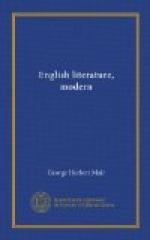Cain and Abel were English farmers just as truly as Bottom and his fellows were English craftsmen. But then Julius Caesar has a doublet and in Dutch pictures the apostles wear broad-brimmed hats. Squeamishness about historical accuracy is of a later date, and when it came we gained in correctness less than we lost in art.
The miracle plays, then, are the oldest antecedent of Elizabethan drama, but it must not be supposed they were over and done with before the great age began. The description of the Chester performances, part of which has been quoted, was written in 1594. Shakespeare must, one would think, have seen the Coventry cycle; at any rate he was familiar, as every one of the time must have been, with the performances; “Out-heroding Herod” bears witness to that. One must conceive the development of the Elizabethan age as something so rapid in its accessibility to new impressions and new manners and learning and modes of thought that for years the old and new subsisted side by side. Think of modern Japan, a welter of old faiths and crafts and ideals and inrushing Western civilization all mixed up and side by side in the strangest contrasts and you will understand what it was. The miracle plays stayed on beside Marlowe and Shakespeare till Puritanism frowned upon them. But when the end came it came quickly. The last recorded performance took place in London when King James entertained Gondomar, the Spanish ambassador. And perhaps we should regard that as a “command” performance, reviving as command performances commonly do, something dead for a generation—in this case, purely out of compliment to the faith and inclination of a distinguished guest.
Next in order of development after the miracle or mystery plays, though contemporary in their popularity, came what we called “moralities” or “moral interludes”—pieces designed to enforce a religious or ethical lesson and perhaps to get back into drama something of the edification which realism had ousted from the miracles. They dealt in allegorical and figurative personages, expounded wise saws and moral lessons, and squared rather with the careful self-concern of the newly established Protestantism than with the frank and joyous jest in life which was more characteristic of the time. Everyman, the oftenest revived and best known of them, if not the best, is very typical of the class. They had their influences, less profound than that of the miracles, on the full drama. It is said the “Vice”—unregeneracy commonly degenerated into comic relief—is the ancestor of the fool in Shakespeare, but more likely both are successive creations of a dynasty of actors who practised the unchanging and immemorial art of the clown. The general structure of Everyman and some of its fellows, heightened and made more dramatic, gave us Marlowe’s Faustus. There perhaps the influence ends.




